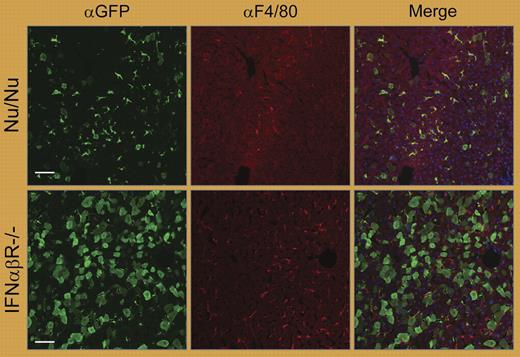In this issue, Brown and colleagues show that a single component of the innate immune system limits lentiviral gene transfer to hepatocytes in vivo and at the same time is required for a subsequent adaptive immune response against the transgene.
Over the past decade, lentiviral vectors have emerged as powerful tools for ex vivo gene transfer to hematopoietic stem cells, thereby raising the possibility of developing gene therapies for hematologic disorders that were previously unrealistic targets.1 In contrast to other retroviruses, these vectors are capable of transducing dividing and nondividing cells. However, hepatocytes have been difficult to transduce in vivo with these vectors. Transgene expression within the liver occurred primarily in sinusoidal cells (endothelial cells and Kupffer cells) rather than hepatocytes.2 Moreover, these vectors also transduced antigen-presenting cells (APCs) in liver and spleen and induced a cytotoxic T-lymphocyte response against the transgene product, which resulted in CD8+ T-cell infiltrates in the liver and elimination of transduced cells.2
Recent advances in vector engineering reduced the potential for an immune response by changing the viral envelope protein, by restricting expression to hepatocytes, or, in an innovative new approach, by taking advantage of endogenous microRNA regulation to suppress expression in professional APCs.2-4 Lentiviral vectors are derived from human immunodeficiency virus (HIV), a virus that activates plasmacytoid dendritic cells, resulting in an antiviral type I interferon response.
In this issue of Blood, Brown and colleagues show in very elegant work that lentiviral vectors not only elicit a similar innate immune response, which in turn triggers an adaptive response against the transgene product, but that the production of IFNαβ severely limits transduction of hepatocytes. The authors demonstrate that infection by the vector rather than the vector particle by itself causes the innate response, and that the vector activates plasmacytoid dendritic cells. In IFNαβ-deficient mice, more than 30% of hepatocytes were transduced, substantially more than in any previous report on hepatic gene transfer with this vector system (see figure). Moreover, expression was sustained and not limited by a T-cell response. These findings are exciting, because interference with a single pathway, interferon production, should achieve 2 important goals: higher efficacy and lack of immune responses to the transgene product.
The IFNαβ response, and not the adaptive immune system, affects the liver transduction profile of LVs. See the complete figure in the article beginning on page 2797.
The IFNαβ response, and not the adaptive immune system, affects the liver transduction profile of LVs. See the complete figure in the article beginning on page 2797.
Clearly, more work is required to fully understand the interactions between the target organ and the viral vector, and the new study already raises additional questions. For example, T-cell responses to the transgene product in IFNαβ−/− mice were measured in vitro, but for unknown reasons did not limit expression in vivo. There are also general concerns about the safety of integrating vectors. Nonetheless, given the published evidence for tolerance induction to therapeutic gene products by hepatic gene transfer and a likely lack of memory responses to lentiviral vectors in humans, this line of research has great potential for the future.5 It is critical for the advancement of gene therapy that we better understand the basic biology of interactions between the target organ and the gene transfer vectors, including organ-specific immunity.
The author declares no competing financial interests. ▪


